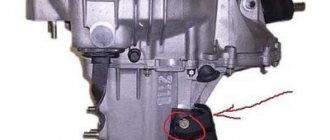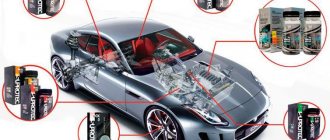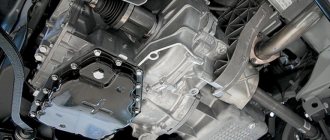Why does a manual transmission howl?
Many manual transmissions, even in good condition, are not very quiet. Even on a new car, the transmission can make sounds while driving, this is especially true for vehicles in the budget segment. For example, the whine of a VAZ gearbox is the norm for many cars. Every owner knows what the normal noise level is inside his car, and will always notice changes. If the noise of the box changes in tone, competes in volume with the sound of the engine, or appears in some specific conditions, you need to think about a visit to a car service center.
Many people confuse noise in the box with malfunctions of other elements. Often, while driving, a worn-out release bearing howls. The volume and tone of the noise directly depends on the speed of movement, so the diagnosis of “box whine” is mistakenly made. A clutch that requires replacement can also cause a similar problem. Without diagnostics, it is difficult to figure out what causes the unpleasant sound, so it is better to contact a car repair shop.
If the manual transmission itself makes a hum, there may be several reasons:
- If there is insufficient lubrication, a hum may occur due to intense friction of parts. The howl is heard especially clearly in higher gears.
- Noise may occur after improper repair of the gearbox. Assembly requires precision. If the shafts and gears are misaligned relative to each other, the box will make noise.
- A common cause of noise is failure of synchronizers. This malfunction is usually accompanied by a grinding noise when engaging certain gears.
- If the noise is present when the gear selector is in neutral, there is likely a problem with the input shaft bearing.
- The pinion bearing may also make a noise.
- Wear of the main pair is another source of box howling. If measures are not taken in time, other parts will also fail.
- If the whine is only heard in a certain gear, the cause lies in the gears. If their teeth are damaged, the box will hum.
- If the box hums when cold, especially in the winter, the culprit may be that the oil is too thick. After warming up, the transmission is much quieter.
- Old oil in a box may contain metal shavings and other impurities. This may be the cause of the noise.
If a howl appears in the box, pay attention when it occurs, whether its pitch and volume changes in different modes. If noise appears when the clutch is depressed, there is a crunching sound when engaging 1st or 2nd gears, there is a high probability of wear of the release bearing. Extraneous sounds when engaging certain gears indicate problems with gears or synchronizers. A humming noise in higher gears or in cold gears may indicate an insufficient level or low quality of transmission oil.
Automatic transmission whine when shifting gears
Sometimes when you start driving, you can hear a suspicious sound resembling a howl from under the hood. This usually happens when shifting into second gear. In most cases, the source is the front planetary gear. This unit begins to make sounds when the transmission is heavily worn. Some drivers do not attach much importance to this and wait until the planetary gearset completely falls apart and a “meat grinder” of gears is formed, but this should not be allowed to happen.
The constant desire to reduce the cost of mechanisms simply cannot but affect their quality. The planetary mechanism quickly begins to break down the axes of the satellite gears. This leads to a change in the contact patch between the sun gears and satellites, which causes the destruction of their “teeth”. There is only one way out of this situation - replacing the planetary mechanism.
The howl of an automatic transmission, robot or variator
Automatic transmissions are normally quieter than manual transmissions. If the howl of a manual Niva or Lada Kalina transmission may be a normal condition of the transmission, then third-party sounds from the automatic transmission should alert the car owner. Diagnosing the causes of third-party sounds when operating automatic transmissions is quite difficult. Sometimes computer diagnostics can help identify the problem, but in most cases you have to remove and disassemble the transmission. Having learned the cost of this procedure, many continue to drive a car and drown out the howling with loud music. But this is wrong; with significant wear of all internal components, repairs will cost more than with minor problems. In addition, a faulty transmission can fail at any time.
The main reasons for howling automatic transmission:
- If there is little transmission fluid in the box, usually not only extraneous sounds appear, but also kicks when changing gears.
- If the automatic transmission starts to howl after repair, it may have been assembled incorrectly. Even a slight displacement of parts leads to the appearance of third-party sounds.
- If the axle shafts are poorly secured, play occurs, which leads to noise.
- The quality of the transmission fluid also affects the operation of the automatic transmission. If the oil is old, contains mechanical impurities, or a fluid that does not meet the manufacturer’s requirements is filled in, the box will begin to hum.
- Worn or damaged gears, bearings and other mechanical parts lead to the appearance of extraneous sounds.
An automatic transmission is a rather complex mechanism compared to a manual transmission, which is why it is more difficult to identify the cause of the howling. But even if you need to disassemble the transmission with troubleshooting, it is better to perform this procedure than to face a critical breakdown along the way.
Finalization
Purpose: install a gasket between the clutch cable and the gearbox fork
Procedure:
- Remove the clutch cable end from the fork.
- Unscrew the cable end, having previously measured the length of the free threads.
- Remove the clutch cable boot.
- Remove the rubber insert from the cable stop (photo No. 1).
- Instead, install a round washer made of porous rubber (diameter 32-35 mm, hole 12-13 mm) (photo 2).
- Cut a piece of rubber measuring 20x70 mm, 2.5-3 mm thick.
- Glue it (for example, with “Moment” glue) to the plastic cable stop (one turn), secure with electrical tape 1.5 turns.
- Insert the cable into the bracket on the gearbox and put on the boot.
- Screw on the tip, leaving a couple of millimeters less free threads on the stud (since the new gasket is thicker than the factory part).
- Place a 2 mm foam rubber spacer between the cable tip and the fork lever.
- Adjust the clutch pedal.
As a result: the effect was noticeable immediately. Now the rattling can only be heard with the windows open. After modifying the clutch cable fastening, the car drove more than 15 thousand km, the gearbox noise was within normal limits. Increased vibrations and noise were noticed only at a temperature of -20°C, when the rubber gaskets become hard. The author has posted sound files (engine acceleration-braking mode at 1500-2000 rpm in 3rd gear), which shows what the noise was from the gearbox before and after modification. Site users can download the file:
To download files you need to log in to the site To download files you need to log in to the site
On foreign cars, increased clutch cable vibrations are dealt with using a special weight (Renault Logan cable). You can repeat the foreign experience in a garage, for example, wrap a bitumen ball around the cable sheath (taken from a vibration damper).
Let us remind you that owners of Lada Granta, Kalina and Priora cars also encounter clicks in the clutch pedal.
Keywords: sound insulation of Lada Granta | sound insulation of Lada Kalina | sound insulation of Lada Priora | fret pedals granta | fret Kalina pedals | Lada Priora pedals | Lada Granta clutch | clutch Lada Kalina | Lada Priora clutch | gearbox Lada Granta | gearbox Lada Kalina | Lada Priora gearbox
+5
Share on social networks:
Found an error? Select it and press Ctrl+Enter..
What to do if the box howls
The first thing a car owner should think about when a howling noise appears in the transmission is a transmission fluid leak. Inspect the car's riser for oil stains, assess the oil level in the box using the dipstick, which most car models have. If the transmission fluid level is below the minimum mark, it must be topped up immediately. Use only the brand of oil that comes in the box. You cannot mix liquids from different manufacturers. You should know that automatic transmissions are very sensitive to the level of lubrication, so an overflow of transmission fluid is as unacceptable as a lack of it. If the oil has not been changed for a long time, it should be done. Automatic transmissions are especially sensitive to the quality of transmission fluid.
If it was not possible to eliminate the howling of the box by replacing or adding oil, you need to go to a service station for diagnostics. Specialists will assess the condition of the transmission and tell you how much repair is needed.
If you decide to sort through the box, you should take into account that the cost of such work is quite high. That is why it is advisable to purchase new original spare parts. Only in this case can you count on a long service life of the transmission after repair. Buying used spare parts or cheap parts from a dubious manufacturer is an imaginary savings. There is a high probability that soon after such repairs the gearbox will have to be disassembled again.
If the main pair is damaged, it is rarely possible to get by only by replacing it. Usually in such a situation other parts also suffer, so you need to evaluate their condition and, if necessary, also replace them.
Sometimes repairing a box turns out to be very difficult and expensive. In this case, it is advisable to replace the entire transmission. You can buy a new unit or find a used box in working condition.
What can cause a box to howl?
Initially, it is worth noting that VAZ 2107 cars are equipped with five-speed manual transmissions. Structurally, this is a separate unit that is connected to the car engine. The gearbox consists of two main parts - the drive and driven shafts. Gears of different diameters are placed on the shafts, with the help of which the shafts are connected. In addition, the box design contains bearings, gears, synchronizers, and a clutch. The failure of any part contributes to the appearance of characteristic noise, crackling, or hum, when it occurs it is extremely undesirable to operate the machine.
A specialist who has spent half his life in a garage will be able to determine by the sound why the box on a VAZ 2107 howls. It will be more difficult for a beginner to cope with this task, but it is quite possible. To do this, you need to find out what could be the reason that the gearbox is humming on the seven. The reasons for this phenomenon are as follows:
- If the box is noisy, then the reason may be a drop in the oil level in the unit structure. It is easy to identify this cause, since the noise will be heard in all operating modes of the unit, that is, when moving in all gears. You can verify this by checking the oil level. If the level is below the minimum, then you need to add special TAD-17 oil or other gear oil.
- When the box starts to howl, the bearings can contribute to this. Everyone knows that bearings tend to wear out, especially those made from low-quality materials. If the bearings are worn out, it is better to replace them immediately and not delay this moment. After all, the longer you operate a car with a faulty gearbox, the more expensive repairs will subsequently cost.
- Wear of gear teeth - this reason is rare and depends on the nature of driving. The more often you start from second or third gear, the faster the teeth will be licked. In addition, a clutch that is under-pressed or malfunctioning also causes gear teeth to wear out, causing costly repairs.
- Wear of synchronizers and blocking rings on the shaft.
Should I use additives?
There are special additives for gearboxes. Is it worth using them, will they solve the problem of transmission whining?
Additives are effective in preventing breakdowns. Many of them can significantly increase the service life of the transmission. If a minor malfunction occurs, using these products will help temporarily get rid of the noise and delay repair time. But you shouldn’t hope to restore the parts; sooner or later they will have to be replaced anyway.
If the box is severely worn, and even more so if it fails, additives are ineffective. In this case, you shouldn’t spend money on auto chemicals; it’s better to go straight to the service center.
Additives for automatic and manual transmissions differ in their properties. Use automotive chemicals designed for the type of transmission installed in your vehicle. Avoid using products from dubious manufacturers. At best, they will have no effect, and at worst, they will lead to more serious problems.
How to eliminate the howl of a checkpoint on a grant?
After AvtoVAZ introduced a cable-driven gearbox (we are talking about the 2181 manual transmission), the information content and clarity of gear shifting increased.
However, from the first days of using the car, many began to notice gearbox noise (hum, howl). In 2013, the manufacturer received a large number of complaints from owners of the Lada Grant and other front-wheel drive Lada cars, as a result of which it was decided to modify the gearbox. AvtoVAZ conducted research, during which the data on consumer complaints was confirmed. The howl of the gearbox occurred due to poor processing of the teeth of the gears and the main pair. As a result, the design of the manual transmission was finalized within 3 months, and the technological processes of metalworking were changed. As a result, an updated, quieter gearbox entered production in July 2014. According to instrumental monitoring, the noise level in general has been reduced by more than 15 dB (about 25%).
It is worth noting that the howling of the gearbox does not generally affect reliability and wear resistance. To solve the problem of gearbox hum, it is recommended to contact an authorized dealer. You can also reduce noise in the gearbox by replacing the oil in the gearbox with a higher quality one.
gearbox howls on grant
Noise in automatic transmission when cold: reasons
If the problem only appears when it’s cold, you can still drive, but when the gearbox does not stop making noise even when the unit is warmed up, then specialist intervention is necessary. Delay may result in serious damage.
The cause of the noise when the box is not yet warmed up is especially often the jamming of the generator pulley clutch. You can try opening the hood and driving back or forward a little. It will be clearly visible how the transmission belt jerks.
Typically, drivers immediately change the belt and tension pulley. Yes, the problem may be in them, but you still need to inspect the pulley first. To check it, you need to rotate the pulley several times, first in one direction and then in the other direction. If the pulley does not move smoothly when turning, it will have to be replaced. Work here for 10 minutes.
The car doesn't move forward
Usually in this case the reverse gear works properly. The cause may be damage to the discs or piston cups. Another common case is a stuck shift adjustment valve.
To troubleshoot problems, it is necessary to replace the friction discs, change the cuffs and clean the valve. If the reverse speed does not work either, it means that the culprit of the problem is the clutch responsible for the forward speed. Excessive wear will destroy the O-rings, spline mechanism and coupling. Repair in this case will consist of replacing damaged and worn elements.
Why does first gear howl in an automatic transmission?
Sometimes the gearbox hum only appears when driving in first gear. When switching to the second, the unpleasant sound disappears. This means that the problem is in the planetary gear, or rather, in one of its satellites - a group of gears. Over time, the howl of the automatic transmission in first gear only becomes stronger. This leads to transmission scattering and complete engine stop.
The planetary gear needs to be repaired. You can, of course, not rush into a trip to the service station and wait for the mechanism to completely collapse, but such a delay can hurt your wallet. A complete replacement of a planetary gear is more expensive than repairing one of its planetary gears.
By the way, if an unpleasant sound appears only during forced (fixed) transmission, then there is no need to rush into repairs. Try changing the working fluid. But if the noise also appears while driving, this is a serious matter.
Owner reviews
There are many opinions on the Internet about this or that Lada Granta checkpoint. Here are just a few of them.
Vasily, Samara: “Compared to the gearbox from Priora, the new cable gearbox does not hum, does not vibrate, gears are engaged easily and clearly. They say that Granta’s robot leaves much to be desired, but I’m more used to mechanics. At least you know what to expect from her and what problems may arise.”
Georgy, Tambov: “I got this miracle from AMT. In other words, a robot. In combination with the electronic gas pedal, I got a complete “vegetable” that accelerates poorly and thinks slowly. Sometimes it seems that the box thinks for about 6 seconds, and only then switches. Very inconvenient compared to mechanics. Although for lovers of leisurely trips it’s perfect. If you don’t want aggressive driving, a robot is an ideal option.”
Dmitry, city of Izhevsk: “Granta on the machine, who would you have thought that this would happen. What I want to say is that this is an ancient box from Nissan, although not the most advanced, but time-tested. Moderately thoughtful, which is not surprising, given the technology of the last century. For our automobile industry, this can be considered a breakthrough. If only they didn’t think of putting this ancient mammoth on Vesta.”
Automatic transmission hums at speed: what to do?
There may be a buzzing noise in the area of the gearbox when accelerating. As a rule, the automatic transmission hums at a certain speed limit, and then the hum only intensifies. A detailed diagnosis reveals that the place where the noise is generated is the rear part of the automatic transmission, where the connection to the driveshaft occurs. In this case, the system does not generate any errors. This is not yet a reason to panic, and the appearance of unpleasant sounds in this area is not evidence of the “death” of the gearbox. A possible cause is a broken transfer case front bearing (the bearing closest to the front driveshaft).
conclusions
The howling of a Renault, Lada Vesta, Grant or any other car is a problem that cannot be ignored. A working transmission does not make any strange sounds, so if they appear, go to a service center as soon as possible. The sooner the diagnosis is carried out, the cheaper the repair will cost. If you constantly postpone this event, then the howl may end in buying a new box.
The gearbox is a rather complex unit, especially when it comes to an automatic transmission. Do not trust repairs and diagnostics to random people. It is better to contact a specialized auto repair shop that has the necessary equipment and tools.
VAZ checkpoint, a frequent source of howling.
Worn synchronizers are a source of increased noise. For replacement.
A worn input shaft bearing is another enemy of silence.
A faulty release bearing is a frequent source of additional noise.
edit this post










